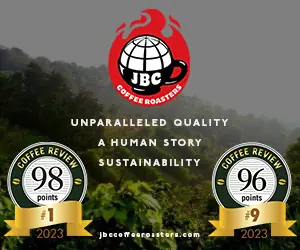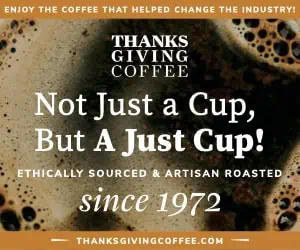Courtesy of Kenneth Davids, 21st Century Coffee: A Guide
Ever since specialty coffee pioneer Alfred Peet popularized Sumatra coffees on the menu of his famous Vine Street store in the late 1960s, their earthy/musty, pungently fruit-toned profile has attracted a particularly loyal following among North American coffee lovers. In part this popularity derives from the strong character of Sumatra coffees, which allows them to stand up to the dark-roasted style of coffee pioneered by Peet’s and later disseminated throughout the world by Starbucks.
Typical Sumatras of that period showed a musty or mildewed note that the industry glamorized as “earthy” plus (often) a pungent fruit that owed at least a little of its overripe, twisty character to ferment. Thus these classic Sumatras violated what was at the time an almost sacred tenet of specialty coffee: that the flavor impact of fruit removal and drying ought to be as invisible as possible. Any interference imparted by those processes to the pure taste of a perfectly processed, cleanly bright coffee deserved denunciation from the high pulpit of the specialty coffee priesthood of the time. So, for decades, the specialty industry danced around Sumatras and similar coffees from other Indonesian islands, avoiding understanding them, often secretly condemning them, but selling them anyhow because people liked them.
The Sumatra Mystery Resolved
But now the peculiar post-harvest procedure that facilitates the characteristic Sumatra flavor profile has a name: wet hulling. I saw these unorthodox procedures firsthand in 1996 and thereafter applied various names to them in my books and articles: “traditional Sumatra processing,” “backyard wet processing,” etc. None of these names stuck. But when Australian coffee scientist Tony Marsh delivered a paper at the 2009 Specialty Coffee Association of America Symposium describing these techniques in detail and dubbing them “wet hulling,” the new name and the understanding that came with it stuck.
Upgraded Wet Hulling
In recent years some producers and exporters are working from a better understanding of the traditional procedures contributing to the wet-hulled cup profile and are exploiting them with greater precision. In other words, what has been a traditional, rather haphazard procedure with accidental impact on coffee flavor is now often applied with increasing deliberateness by strengthening quality procedures all along the complex Sumatra supply chain, aimed at producing a more consistent version of the Sumatra wet-hulled style.
Moderate growing elevations, typical terroirs and certain local varieties of Arabica doubtless also have something to do with the unique character of Sumatra and other wet-hulled Indonesia coffees, but the peculiarities and impact of wet hulling appear to be paramount in defining their character.
Sumatra Growing Regions
There are two traditional, broadly defined growing areas in Sumatra. These two regions differ in terrain, in some growing practices and in local culture, but the same broad tendencies in cup character apply to both, given the very similar dominant wet-hulled processing methods and a similar range of tree varieties. Differences among specific lots of coffee do not appear to be determined by region, but more by management of the complex supply chain stretching from small-holder producers through the various stages of hulling and drying.
Lintong/Mandheling.
Lintong properly describes only coffees grown in a relatively compact region just southwest of Lake Toba in the kecamatan or district of Lintongnihuta. It is the most admired of Sumatra growing regions. Small plots of coffee are scattered over a high, undulating plateau of fern-covered clay. The coffee is typically grown without shade, though also largely without chemicals and almost entirely by small holders. On the other hand, Mandheling is a more comprehensive, designation, usually referring both to Lintong coffees and to coffees grown under similar conditions elsewhere in the vicinity of Lake Toba. Mandheling is also often used to describe any wet-hulled coffee from Sumatra, including those from the Aceh region.
Aceh/Gayo.
Wet-hulled coffees are produced in the hills near and around Lake Tawar, a lovely crater lake, close to the town of Takengon. Elevations are usually a bit higher than in Mandheling/Lintong, hillsides a bit steeper, and coffee is usually grown in managed shade. Cup profiles are perhaps a bit brighter. Small holders are often members of cooperatives, and these cooperatives frequently offer certified organic as well as fair trade-certified coffees.
Jambi/Kerinci.
Jambi is a province in east-central Sumatra that produces mainly Robusta, but recently began exporting a very interesting, usually wet-hulled Arabica under the market name Kerinci, the name of the region and lush valley in which it is grown. Other such newer Sumatra Arabicas may surface in future.
The Traditional Sumatra Cup
Ordinary Old-Fashioned Wet-Hulled Sumatras.
Often robust and hearty, they can be rough in mouthfeel, with musty notes ranging from rich humus to sharp mildew, and fruit notes from ripe and mango- like to overripe and composty. This older style of Sumatra is often dark-roasted to push the musty fruit toward a dry, hearty chocolate.
The Best of the Newer, Cleaner Style of Sumatras.
Here the sequence of wet-hulling steps has been refined to the point that the earth note is backgrounded and transformed, bringing a peculiarly rich, sweet pungency to complex stone fruit, deep floral and spice notes. This cup profile can be among the world’s finest and most distinctive.
Sumatra Coffee Ratings and Reviews
Click here to view ratings and reviews of coffees from Sumatra.










